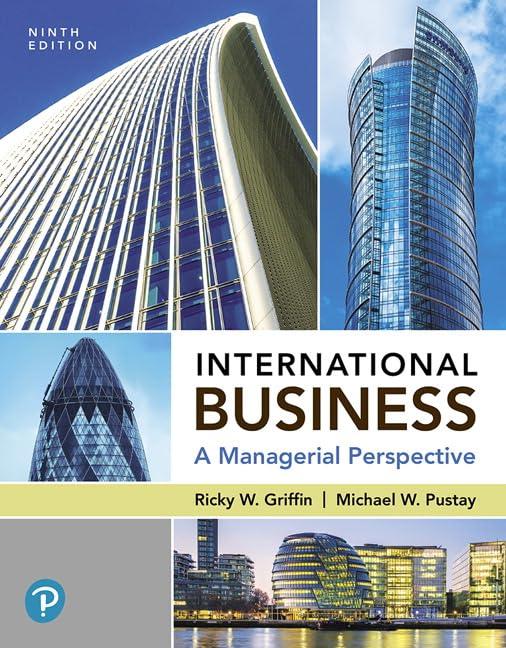Huaweis chief financial officer has argued, Whenever trade protectionism intervenes with competition in the market, it is
Question:
Huawei’s chief financial officer has argued, “Whenever trade protectionism intervenes with competition in the market, it is the consumer who suffers in the end.” Do you agree?
Huawei (pronounced hwah-way), along with Haier, the world’s largest white goods manufacturer, and Lenovo, a leading PC manufacturer, is at the vanguard of Chinese companies that have enjoyed multinational success. Huawei has captured the title of the world’s largest telecommunications equipment manufacturer, displacing Sweden’s Ericsson from that perch. Headquartered in Shenzhen, the company employs 180,000 workers in 170 countries. In 2017, Huawei’s sales reached \($93\) billion. It is a major supplier of mobile and fixed broadband networking equipment. It is the third-largest vendor of smartphones, selling 153 million of them in 2017.
Huawei was founded in 1987 by Ren Zhengfei, who began his career as an engineer in the People’s Liberation Army (PLA). After leaving the army, he sold private branch switching equipment for a Hong Kong manufacturer. He soon turned to manufacturing such equipment under the Huawei name. Ren built his company by producing high-quality products that sell for low prices. Huawei initially focused on serving smaller cities and rural areas in inland China, where competition was less intense. It then expanded into larger Chinese cities. By 1992, Huawei had developed its own digital telephone switch for the mainstream telecommunications market. Two years later Huawei branched into long distance transmission equipment.
Ten years after its founding, Huawei went international, marketing landline networking equipment to Hong Kong’s Hutchinson Whampoa.
Huawei built a research and development (R&D) center in India in 1999, in Sweden in 2000, and four in the United States shortly thereafter. In the 2000s it established R&D joint ventures with 3Com Communications, Siemens, Motorola, and Symantec. To maintain its position in the fiercely competitive and highly innovative telecom equipment market, Huawei plowed \($14\) billion of its revenues into R&D in 2017. Huawei’s strategies seem to be working: over the past five years, its revenues and operating profits grew more than 20 percent annually, driven in part by booming demand for digital services in the Chinese market. The company has staked out strong positions in cloud-based computing and in developing industry standards for 5G networks. Triumphant in its domestic market, Huawei has also successfully competed in international markets, with 49 percent of the company’s revenues generated outside of China. Europe, the Middle East, and Africa account for 27 percent of its revenues. It has partnered with major European carriers like Deutsche Telekom, Telefonica, and Vodafone to provide cloud services and to promote connectivity in the “Internet of Things (IoT)” market. (The IoT market refers to Internet-connected smart vehicles, smart meters, smart homes, and the like.)
However, Huawei’s efforts to enter some markets have been hindered by trade and investment barriers erected by governments in host countries.
Australia stymied Huawei’s proposed collaboration in the construction of a nationwide high-speed broadband network. It discouraged the Solomon Islands from using Huawei as the vendor on an undersea cable project designed to connect those islands to Australia. India limited Huawei’s expansion there as well. Canada’s policy has been ambivalent. Canada’s previous government under the leadership of Conservative Stephen Harper excluded Huawei’s participation in the building of a secure government communications network. However, Prime Minister Justin Trudeau’s (elected in 2015) Liberal Party made improving ties with China an important policy goal, creating a more favorable environment for Huawei and other Chinese firms. Huawei has worked diligently to build its presence in the Canadian market. It has created R&D centers there, employing more than 400 researchers, and formed partnerships with numerous Canadian universities. Huawei and Telus, a leading Canadian telecom provider, have teamed to test market 5G services in Vancouver.
However, the minority Conservative Party continues to raise national security concerns about Huawei’s role in Canada’s information technology infrastructure. Huawei’s primary problem is the United States: it has been effectively banned from many U.S. markets on national security grounds. Huawei’s growing presence in providing critical elements of the information infrastructure has generated concerns about cybersecurity. Critics have raised fears that Huawei could embed computer code in its telecommunications equipment that would facilitate industrial espionage and cyberattacks. In 2012, the U.S. House Permanent Select Committee on Intelligence released a report suggesting that hackers with ties to the PLA were responsible for systematic cyberattacks on numerous U.S.
military, commercial, and journalistic organizations. The congressional report argued that Huawei should be banned from doing business in the United States because of these security issues. A UK parliamentary committee examining Huawei raised similar cybersecurity concerns.
Other critics are suspicious of Ren’s links to the PLA.
Huawei has had some limited success in the United States—its share of the American telecom network equipment market is an estimated one percent—because of the quality of its products and its low prices. One small cable company, Eastern Oregon Telecom, estimated it saved \($150,000\) by purchasing Huawei hardware instead of Ericsson or Nokia products. However, in 2018 the Federal Communications Commission proposed banning Chinese firms from participating in the Universal Service Fund, an \($8\) billion a year program designed to subsidize telecommunications services in rural areas, effectively foreclosing that market to Huawei and its smaller Chinese rival, ZTE Corp. In March 2018, electronics retailer Best Buy decided to end its sales of Huawei’s phones; earlier that year AT&T abandoned a deal to market Huawei phones.
Step by Step Answer:






